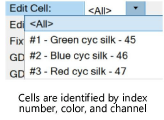 Concept: Multi-cell lighting devices
Concept: Multi-cell lighting devices Concept: Multi-cell lighting devices
Concept: Multi-cell lighting devicesThe Lighting Device tool inserts multi-cell lighting devices, as described in Inserting lighting devices. Multi-cell lighting devices support cell-specific accessories and multiple light emitters.
Multi-cell lighting devices act as a unit but maintain their cell-specific parameters. For example, a three-cell Cyc light is moved and focused as a unit, while each cell retains its own information, such as color and channel number, which displays in its label legend.

The Spotlight preferences: Lighting Devices: Parameters pane defines which parameters are cell-specific. In the Lighting Device Parameters list, a check mark in the Multi-cell column indicates that the parameter supports different cell values.
You can set the parameters for each cell from the Object Info palette of the multi-cell device; see Lighting device properties. Select the cell to edit from the Edit Cell list. Each cell is identified by an index number. This number corresponds to the cell stacking order, starting from back to front (or starting with the first created cell in the default stacking order).

The index number is also used to identify cells when patching. Each cell in the lighting device can be patched individually from the Patch dialog box; see DMX patching. Individual cells can be numbered with the Spotlight Numbering command when you number fields that support cell-specific values. See Numbering light plot objects for more information about the special numbering behavior for multi-cell lighting devices. When generating paperwork, each cell of the lighting device is listed individually.
To create custom multi-cell symbols, see See Workflow: Creating multi-cell symbol definitions.
~~~~~~~~~~~~~~~~~~~~~~~~~